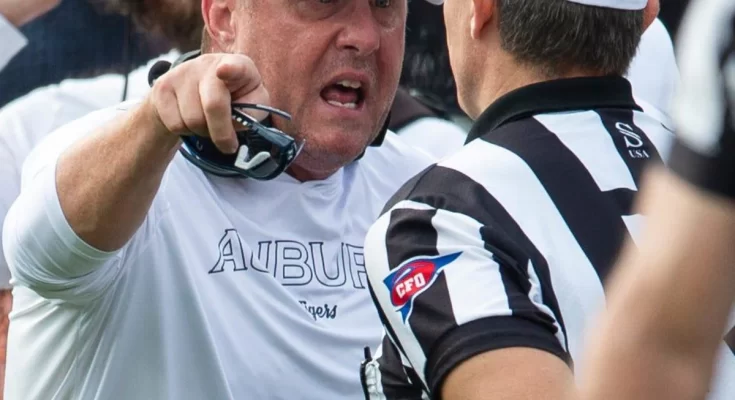Auburn Tigers Face Recruiting Challenges in 2026 Class but Coach Hugh Freeze Remains Optimistic Amid Program Changes
The Auburn Tigers have struggled recruiting in their 2026 class, but head coach Hugh Freeze isn’t too worried, considering the changes to the program and the broader college football landscape that provide hope for a turnaround. Recruiting remains the lifeblood of any college football team’s success, especially in the highly competitive Southeastern Conference, where landing top-tier talent often separates championship contenders from those still rebuilding. Despite the slow start in securing commitments for the upcoming class, Coach Freeze has maintained a steady confidence in the Tigers’ ability to rebound and improve through strategic adjustments and program growth.
Recruiting challenges for Auburn in 2026 can be attributed to several factors, including increased competition within the SEC, shifting player priorities in the NIL era, and the ripple effects of the transfer portal which has altered traditional team-building strategies. However, Auburn’s leadership is approaching these difficulties with a comprehensive plan aimed at strengthening relationships with recruits, enhancing player development opportunities, and leveraging the evolving NCAA regulations to their advantage. Hugh Freeze’s message to fans and stakeholders has been one of patience and trust in the process, underscoring that recruiting momentum often builds in waves and that the program’s long-term vision remains intact.
One major aspect contributing to the recruiting hurdles is the heightened competition in the SEC itself. Programs such as Alabama, Georgia, LSU, and Florida have made significant investments in recruiting infrastructure and NIL partnerships, giving them an edge in attracting elite prospects. These schools are aggressively pursuing top athletes, often offering unprecedented support systems, exposure, and development pathways. Auburn, while traditionally strong in recruiting, has faced difficulties keeping pace with some of these enhanced offers, especially when competing against schools with more recent success or deeper NIL networks. This reality has pushed the Tigers to rethink their recruiting approach in ways that emphasize culture, player development, and personalized support, rather than relying solely on star power or facilities.
The NIL era, while providing players with valuable opportunities to monetize their personal brands, has also complicated recruiting dynamics. Auburn’s recruiting staff has recognized that recruits and their families are now more cautious and discerning about the potential for NIL deals and the stability of those opportunities. As a result, the program has invested in NIL education and partnership programs that aim to create a sustainable, player-friendly environment. By doing so, Auburn hopes to differentiate itself as a program that genuinely supports player success beyond the field, which in turn appeals to recruits seeking holistic development. Coach Freeze has highlighted this approach as a competitive advantage, asserting that Auburn is committed to building champions on and off the gridiron.
The transfer portal, which has transformed how college football rosters are constructed, also plays a significant role in the 2026 recruiting outlook. Many programs, including Auburn, are now balancing the need to sign high school recruits with the strategic acquisition of transfers who can provide immediate impact. This dual focus requires a flexible and responsive recruiting philosophy, one that can pivot as the portal opens and closes throughout the year. Coach Freeze and his staff have adapted by expanding their scouting networks and accelerating decision-making processes. The goal is to ensure that Auburn doesn’t miss out on key portal talent that fits their system and culture, while continuing to cultivate relationships with high school prospects who represent the program’s future.
In addition to on-field talent acquisition, Auburn is also addressing player retention as a crucial factor in roster stability. Keeping current players engaged and motivated through NIL opportunities, academic support, and a strong team culture is vital to minimizing unexpected roster turnover. Freeze has emphasized open communication with players, fostering a family atmosphere where individuals feel valued and supported. This retention strategy is designed to provide a foundation for sustained success, reducing the need to rely heavily on transfers or late-cycle recruits.
Despite the challenges, early indications suggest that Auburn’s recruiting efforts are gaining traction as the cycle progresses. The coaching staff has ramped up their travel schedules, visiting high-priority recruits and their families more frequently, and hosting more on-campus visits to showcase the program’s facilities, academic offerings, and community. Social media campaigns and direct engagement through alumni and former players have also played a role in creating a buzz around Auburn’s recruiting brand. These combined efforts demonstrate that the program is serious about reversing its early struggles and building momentum heading into the official signing periods.
Fans and boosters have shown mixed reactions to the slow recruiting start. While some express concern about Auburn’s ability to compete with the conference’s elite programs, others remain supportive of Coach Freeze and believe that his approach will yield results over time. Boosters have increased financial support for recruiting initiatives and NIL-related programs, signaling their commitment to helping the Tigers regain their competitive edge. Meanwhile, the media continues to analyze Auburn’s recruiting progress closely, comparing it to other SEC programs and projecting potential outcomes based on current trends.
The Auburn Tigers’ coaching staff understands that recruiting is only one piece of a larger puzzle. Player development, scheme adjustments, and on-field performance will ultimately determine how the 2026 class contributes to the program’s success. Freeze and his assistants are working diligently to ensure that every athlete, regardless of star rating, reaches their full potential through tailored training, mentorship, and mental conditioning programs. These efforts are intended to maximize the value of each recruit, turning under-the-radar prospects into impact players and leaders.
As Auburn moves forward, the importance of maintaining a strong relationship with recruits cannot be overstated. The Tigers’ staff is focused on cultivating trust and transparency, regularly updating prospects on the program’s direction and their potential role within it. This personalized attention helps differentiate Auburn in a crowded recruiting marketplace, where many programs are vying for the same players. By positioning itself as a family-oriented and player-first program, Auburn aims to win over recruits who prioritize stability, development, and a winning culture.
Looking to the future, Auburn’s recruiting strategy for 2026 is designed not only to address immediate needs but also to build a sustainable foundation. The staff is developing long-term pipelines in key regions, forging connections with high school coaches and community programs that feed talent into the program year after year. These relationships are critical to establishing Auburn as a premier destination for top talent and ensuring a steady flow of quality players for seasons to come.
In conclusion, while the Auburn Tigers have encountered recruiting struggles in their 2026 class, head coach Hugh Freeze’s optimism remains rooted in a broader vision of program growth and adaptation. The challenges presented by heightened competition, NIL complexities, and the transfer portal require a multifaceted and patient approach. Auburn’s investments in player development, NIL education, and recruiting relationships are beginning to bear fruit, and the program’s culture-centric philosophy aims to attract players who will thrive both on and off the field. As the Tigers continue to navigate this evolving landscape, their commitment to building a resilient and competitive program offers hope that the 2026 recruiting class will serve as a stepping stone to greater achievements ahead.



